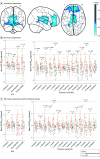Outcomes and Mechanisms Associated With Selective Thalamic Neuronal Loss in Chronic Traumatic Brain Injury
- PMID: 39106064
- PMCID: PMC11304117
- DOI: 10.1001/jamanetworkopen.2024.26141
Outcomes and Mechanisms Associated With Selective Thalamic Neuronal Loss in Chronic Traumatic Brain Injury
Abstract
Importance: The chronic neuronal burden of traumatic brain injury (TBI) is not fully characterized by routine imaging, limiting understanding of the role of neuronal substrates in adverse outcomes.
Objective: To determine whether tissues that appear healthy on routine imaging can be investigated for selective neuronal loss using [11C]flumazenil (FMZ) positron emission tomography (PET) and to examine whether this neuronal loss is associated with long-term outcomes.
Design, setting, and participants: In this cross-sectional study, data were collected prospectively from 2 centers (University of Cambridge in the UK and Weill Cornell Medicine in the US) between September 1, 2004, and May 31, 2021. Patients with TBI (>6 months postinjury) were compared with healthy control participants (all aged >18 years). Individuals with neurological disease, benzodiazepine use, or contraindication to magnetic resonance imaging were excluded. Data were retrospectively collated with nonconsecutive recruitment, owing to convenience and scanner or PET ligand availability. Data were analyzed between February 1 and September 30, 2023.
Exposure: Flumazenil voxelwise binding potential relative to nondisplaceable binding potential (BPND).
Main outcomes and measures: Selective neuronal loss identified with FMZ PET was compared between groups on voxelwise and regional scales, and its association with functional, cognitive, and psychological outcomes was examined using Glasgow Outcome Scale (GOS) scores, measures of sustained executive attention (animal and sustained fluency), and 36-Item Short Form Health Survey (SF-36) scores. Diffusion tensor imaging was used to assess structural connectivity of regions of cortical damage, and its association with thalamic selective neuronal loss.
Results: In this study, 24 patients with chronic TBI (mean [SD] age, 39.2 [12.3] years; 18 men [75.0%]) and 33 healthy control participants (mean [SD] age, 47.6 [20.5] years; 23 men [69.7%]) underwent FMZ PET. Patients with TBI had a median time of 29 (range, 7-95) months from injury to scan. They displayed selective neuronal loss in thalamic nuclei, over and above gross volume loss in the left thalamus, and bilateral central, mediodorsal, ventral-lateral dorsal, anterior, and ventral anterior thalamic nuclei, across a wide range of injury severities. Neuronal loss was associated with worse functional outcome using GOS scores (left thalamus, left ventral anterior, and bilateral central, mediodorsal, and anterior nuclei), worse cognitive outcome on measures of sustained executive attention (left thalamus, bilateral central, and right mediodorsal nuclei), and worse emotional outcome using SF-36 scores (right central thalamic nucleus). Chronic thalamic neuronal loss partially mirrored the location of primary cortical contusions, which may indicate secondary injury mechanisms of transneuronal degeneration.
Conclusions and relevance: The findings of this study suggest that selective thalamic vulnerability may have chronic neuronal consequences with relevance to long-term outcome, suggesting the evolving and potentially lifelong thalamic neuronal consequences of TBI. FMZ PET is a more sensitive marker of the burden of neuronal injury than routine imaging; therefore, it could inform outcome prognostication and may lead to the development of individualized precision medicine approaches.
Conflict of interest statement
Figures



References
-
- Kawai N, Maeda Y, Kudomi N, Yamamoto Y, Nishiyama Y, Tamiya T. Focal neuronal damage in patients with neuropsychological impairment after diffuse traumatic brain injury: evaluation using 11C-flumazenil positron emission tomography with statistical image analysis. J Neurotrauma. 2010;27(12):2131-2138. doi:10.1089/neu.2010.1464 - DOI - PubMed
-
- Shiga T, Ikoma K, Tsukamoto M, et al. . The loss of neuronal integrity may be one of the causes of cognitive disturbances in the patients with brain traumatic injury and normal FLAIR and T2-weighted MRI. Int Congr Ser. 2004;1264(C):177-180. doi:10.1016/j.ics.2003.12.055 - DOI
Publication types
MeSH terms
Substances
Grants and funding
LinkOut - more resources
Full Text Sources
Medical

